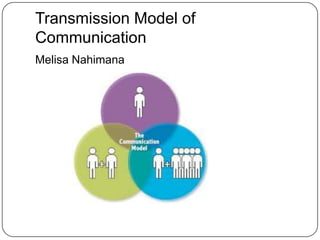Transmission model of_communication[1]
- 1. Transmission Model of CommunicationMelisa Nahimana
- 2. DefinitionA model invented by Shannon and WeaverModel that was invented in 1949It has been considered a mathematical interpretation of how communication between different parties is ought to functionThe purpose of the model is to communicate to one anotherAccording to the book Communication Theories in action, communication can be defined as ŌĆ£ a systematic process in which individuals interact with and through symbols to create and interpret meanings.ŌĆØThe transmission model of communication helps us assist how communication works
- 3. Elements of the Transmission ModelSender EncodingMessageChannelReceiverDecodingFeedbackNoise
- 4. SenderSource of the message Responsible for the encoding of a messageResponsible for the success or failure of the sending of a messageAccountable for accurate information deliveryChooses the transmission channel of the messageInitially leads the argumentative environmentPresents in front of an audience Sender presents one out of multiple truthsBy representing a certain truth, the sender sets a standard for a new ideaSender has to follow the continuum of argumentative certainty ( Marteney, 14)
- 5. EncodingVerbal and nonverbal symbols
- 6. Idea and thought being reflected
- 7. Information is based on the production of the sender
- 8. Dependant on the sender
- 9. Transformation if idea into the universal reality , e.g. virtual reality
- 10. Perception process ( Marteney, 71) to come t light during the encoding process
- 11. Filters that may be used could be psychologically, physically, sensitively or formally ( Marteney 74-75)MessageThe matter the source or sender is communicating about Considered the object of communication, controlled by the senderVerbal or nonverbalTo receive for the senderManner for the sender to convey a certain matterMessages can include claims, and contentions- Claims and contentions may incorporate evidence and reasoning ( Marteney )
- 12. Channel
- 13. ChannelMeans for the sender to communicate to the receiverOutlet to send a message back from the receiver to the sender ( also known as feedback)Usage as avenue to conversean argument in the area of critical thinkingPath for an individual to express oneself verbally or non-verballyTo stimulate one of the five senses: sight, sound, touch, taste, and smellChannels contain the right time, place and occasion ( Marteney, 85)Consideration of word choice, ambiguity, definition and intensity( Marteney, 85)Meanings reflected through channel, either denotative or connotativeThe critical thinker must therefore use the channel eloquently, so that his or her argument is going to be admitted as a reliable truth
- 14. ReceiverAudience
- 15. The end of the communication channel
- 16. Decoded message to be listened and observed by the recipient
- 17. To be beneficiary of critically analyst information from the dispatcher
- 18. Eligible to send back feedback
- 19. Meaning of the message to be understood by receiver
- 20. Receiver to be target
- 21. Motivation of the audience also to be related to be a sufficient receiver ( Marteney)DecodingConverting code symbols back into information ŌĆōconducted by the receiverTranslation to a specific interpretation which has been encoded by the senderContexts may influence the way one decodes an ideaPerception process ( Marteney, 71) to come to light during the decoding processArguments supported by claims, contentions and evidence to be interpreted in a certain way
- 22. Feedback Information send back to the sourcePart of a cause and effect chainVerbal and nonverbal manner of respondComes from the receiver of a messagePurpose is to modify the senderŌĆÖs idea or implicationFeedback can include the same elements of the message: claims and contentionsClaims and contentions supported by evidence and reasoning
- 23. NoiseAnything that disrupts or distorts the communication processVerbal and nonverballyNoise does not necessarily have to come from the audience or anyone in the room Maybe viewed as negative disruptionNoise may also be a source of an indirect message-e.g. the matter of the orator may not be appropriate for the audience
- 24. Transmission Model in Critical ThinkingThrough the lenses of the Transmission Model, a truth can be communicated to an audienceThe matter mathematically to be explained through the transmission model, which should be followed by a qualified persuaderReasoning needed to be understood for all parties included Foundations of Knowledge to be essential on Decision-making situations- which is the reason why the speaker must know what he or she is conversing aboutArgumentative Environment to be created by the speaker with the assistance of the Transmission ModelInclusion of the audience by understanding its context, and accepting its feedback should be incorporated in the critical thinking process












